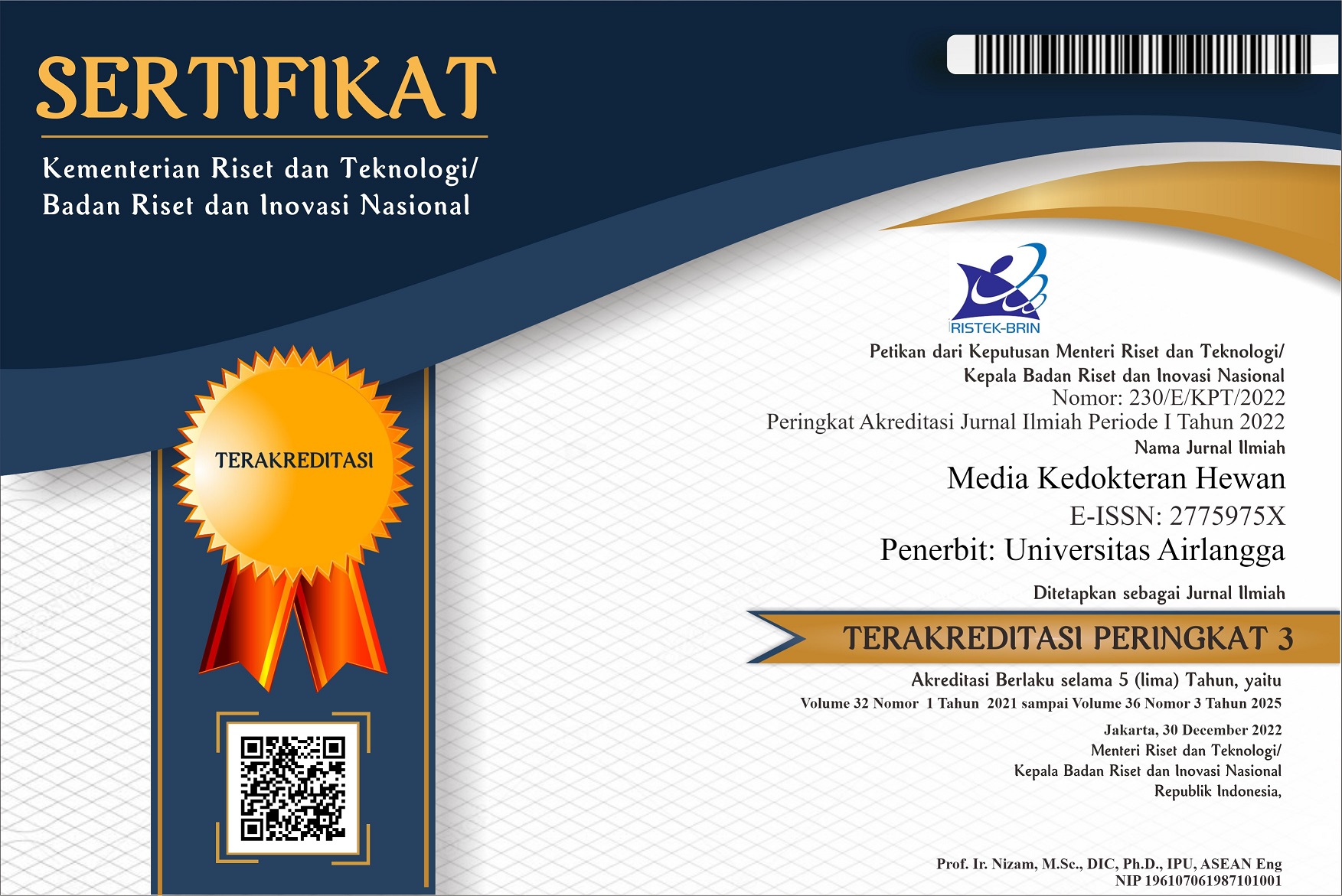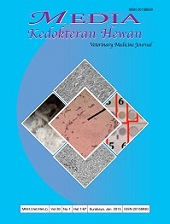The Prevalence of Scopulariopsis sp. and Penicillium sp. in African Pygmy Hedgehogs (Atelerix albiventris) Skins in a Farm in Bogor District of Indonesia
Downloads
This research aims to detect the prevalence of Scopulariopsis sp. and Penicillium sp. in African pygmy hedgehogs (Atelerix albiventris) bred at Golden Dhonje Farm, Bogor District. Twenty hedgehogs were sampled to detect the presence of Scopulariopsis sp. and Penicillium sp. The clinical signs in the sampled African pygmy hedgehogs include alopecia, crusty skin, and dermatitis. The presence of the fungus was confirmed by taking skin samples and then culturing them on Potato Dextrose Agar (PDA) supplemented with chloramphenicol and cycloheximide. Macroscopic and microscopic morphology were observed to identify the two fungal genera. Twenty hedgehogs were sampled, and the results showed that eight of them (40%) were infected with Scopulariopsis sp., six (30%) were infected with Penicillium sp., and four (20%) were co-infected with both species. The total prevalence of hedgehogs affected by these fungi is 90%. This study found differences in infection rates of Scopulariopsis sp. and Penicillium sp. among different age groups and sexes. This study is the first to isolate Scopulariopsis sp. and Penicillium sp. from the skins of African pygmy hedgehogs in Indonesia, which are potential zoonotic pathogens. Further research is needed to expand the sample area, identify other types of fungi, and enhance the understanding of fungal diseases in African pygmy hedgehogs, thereby ensuring the safety of these animals in Indonesia.
Aftab, G., Arfaee, F., Asghari, A., and Salehi. T.Z., 2023. The evaluation of normal ocular parameters in two breeds of hedgehogs. Vet. Med. Sci., 9(2), pp.738–743. DOI: https://doi.org/10.1002/vms3.1055
Apprich, V., Spergser, J., Rosengarten, R., Hinterhofer, C., and Stanek. C., 2010. Scanning electron microscopy and fungal culture of hoof horn from horses suffering from onychomycosis: Vet. Dermatol., 21(4), PP.335–340. DOI: https://doi.org/10.1111/j.1365-3164.2009.00864.x
Atalay, A., Koc, A.N., Akyol, G., Cakir, N., Kaynar, L., and Ulu-Kilic, A., 2016. Pulmonary infection caused by Talaromyces purpurogenus in a patient with multiple myeloma. Infez. Med., 24(2), pp.153-157
Babič, M., Gunde-Cimerman, N., Vargha, M., Tischner, Z., Magyar, D., Veríssimo, C., Sabino, R., Viegas, C., Meyer, W., and Brandão, J., 2017. Fungal contaminants in drinking water regulation? A tale of ecology, exposure, purification and clinical relevance. Int. J. of Environ. Res. Public Health, 14(6): 636. DOI: https://doi.org/10.3390/ijerph14060636
Bexton, S., and Nelson, H., 2016. Comparison of two systemic antifungal agents, itraconazole and terbinafine, for the treatment of dermatophytosis in European hedgehogs (Erinaceus europaeus). Vet. Dermatol., 27(6): 500. DOI: https://doi.org/10.1111/vde.12378
da Costa, F. V. A., Spanamberg, A., Araujo, R., Werner, J., and Ferreiro, L., 2019. Feline sino-orbital fungal infection caused by Aspergillus and Scopulariopsis. Acta Sci. Vet., 47(Suppl 1): 383. DOI: https://doi.org/10.22456/1679-9216.91581
Crofts, S. B., and Stankowich, T., 2021. Stabbing spines: a review of the biomechanics and evolution of defensive spines. Integr. Comp. Biol., 61(2): pp.655–667. DOI: https://doi.org/10.1093/icb/icab099
De Macedo, P. M., and Freitas, D. F. S., 2021. Superficial Infections of the Skin and Nails. Encyclopedia of Mycology, 1(2021), pp.707-718. DOI: https://doi.org/10.1016/B978-0-12-809633-8.21015-7
El-Said, A. H. M., Sohair, T. H., and El-Hadi, A. G., 2009. Fungi associated with the hairs of goat and sheep in Libya. Mycobiology, 37(2): pp.82–88, DOI: https://doi.org/10.4489/MYCO.2009.37.2.082
Eze, E. M., Ezebialu, C. U., Unegbu, V. N., and Nneji, I. R., 2019. Prevalence of keratinophilic fungi and other dermatophytes from soils of Nnewi in Anambra state, Nigeria. Novel Res. Microbiol. J., 3(3): pp.379–386. DOI: https://doi.org/10.21608/nrmj.2019.37211
Fitzpatrick, J. E., High, W. A., and Kyle, W. L., 2018. Nail Disorders, in Urgent Care Dermatology: Symptom-Based Diagnosis: Elsevier, pp. 403–428, DOI: https://doi.org/10.1016/B978-0-323-48553-1.00025-2
Gautam, M., and Bhatia, S., 2020. Mount the menace! – Potassium hydroxide in superficial fungal infections. Indian J. Paediatr. Dermatol., 21(4): 343, DOI: https://doi.org/10.4103/2319-7250.296851
Gomes, B., Pena, P., Cervantes, R., Dias, M., and Viegas, C.., 2022. Microbial contamination of bedding material: One health in poultry production. Int. J. Environ. Res. Public Health., 19(24): 16508. DOI: https://doi.org/10.3390/ijerph192416508
Hamada, N., Baba, T., and Sakuma, D., 2024. Culturable keratinophilic fungi isolated from house dust by hair-baiting technique. Int. Biodeterior. Biodegrad., 186:105702, DOI: https://doi.org/10.1016/j.ibiod.2023.105702
Hamm, P. S., Mueller, R. C., Kuske, C. R., and Porras-Alfaro, A., 2020. Keratinophilic fungi: Specialized fungal communities in a desert ecosystem identified using cultured-based and Illumina sequencing approaches. Microbiol. Res., 239:126530, DOI: https://doi.org/10.1016/j.micres.2020.126530
Hampson, E. C. G. M., Gibson, J. S., Barot, M.., Shapter, F. M., and Greer, R. M., 2019. Identification of bacteria and fungi sampled from the conjunctival surface of normal horses in South‐East Queensland, Australia. Vet. Ophthalmol., 22(3): pp.265–275. DOI: https://doi.org/10.1111/vop.12587
Ilhan, Z., Ekin, I. H., Koltas, S., Gulaydın, O., Ozturk, C., and Borum, A. E., 2016. Occurrence of fungal agents in mastitis in dairy goats. J. Anim. Plant Sci., 29(3): pp.4691–4700.
Iwen, P. C., Schutte, S. D., Florescu, D. F., Noel-Hurst, R. K., and Sigler, L., 2012. Invasive Scopulariopsis brevicaulis infection in an immunocompromised patient and review of prior cases caused by Scopulariopsis and Microascus species, Med. Mycol., 50(6): pp.561–569. DOI: https://doi.org/10.3109/13693786.2012.675629
Kainz, K., Bauer, M. A., Madeo, F., and Carmona-Gutierrez, D., 2020. Fungal infections in humans: the silent crisis: Microb. Cell., 7(6): pp.143–145, DOI: https://doi.org/10.15698/mic2020.06.718
Macura, A. B., and Skóra, M., 2015. 21-year retrospective study of the prevalence of Scopulariopsis brevicaulis in patients suspected of superficial mycoses. Postep. Derm. Alergol., XXXII(3): pp.189–194. DOI: https://doi.org/10.5114/pdia.2014.40965
Molina-López, R. A., Adelantado, C., Arosemena, E. L., Obón, E., Darwich, L., and Calvo, M. A., 2012. Integument mycobiota of wild European hedgehogs (Erinaceus europaeus) from Catalonia, Spain. Int. Scholar. Res. Net. Microbiol., 2012: pp.1–5. DOI: https://doi.org/10.5402/2012/659754
Ogawa, S., Shibahara, T., Sano, A.., Kadota, K., and Kubo, M., 2008. Generalized hyperkeratosis caused by Scopulariopsis brevicaulis in a Japanese black calf. J. Comp. Pathol., 138(2–3): pp.145–150. DOI: https://doi.org/10.1016/j.jcpa.2007.10.004
Ozturk, D., Adanir, R., and Turutoglu, H., 2009. Superficial skin infection with Scopulariopsis brevicaulis in two goats: a case report. Bull. Vet. Inst. Puławy., 53(3):3 pp.61–363.
Pignon, C., and Mayer, J., 2011. Zoonoses of ferrets, hedgehogs, and sugar gliders. Vet. Clin. North Am. Exot. Anim. Pract., 14(3): pp.533–549, DOI: https://doi.org/10.1016/10.1016/j.cvex.2011.05.004
Prayuda, I. M. B., Jayanti, P. D., and Soma, I. G., 2023. Fungal dermatitis in local cat: Vet. Sci. Med. J., 5(08): pp.98–108. DOI: https://doi.org/10.1016/10.24843/vsmj.2023.v5.i08.p10
Rodríguez-Andrade, E., Stchigel, A. M., and Cano-Lira, J. F., 2021. New xerophilic species of Penicillium from soil. J. Fungi., 7(2): 126, DOI: https://doi.org/10.1016/10.3390/jof7020126
Rosa, M., Cardozo, , L. M.., Da Silva Pereira, J., Brooks, D. E.,. Martins, A. L. B., Florido, P. S. S., and Stussi, J. S. P., 2003. Fungal flora of normal eyes of healthy horses from the State of Rio de Janeiro, Brazil. Vet. Ophthalmol., 6(1): pp.51–55, DOI: https://doi.org/10.1046/j.1463-5224.2003.00267.x
Samanta, I.. 2015. Veterinary Mycology. New Delhi, Springer India. DOI: https://doi.org/10.1007/978-81-322-2280-4
Sattasathuchana, P., Bumrungpun, , C., and Thengchaisri., N., 2020. Comparison of subclinical dermatophyte infection in short- and long-haired cats. Vet. World., 13(12): pp.2798–2805. DOI: https://doi.org/10.14202/vetworld.2020.2798-2805
Sri-Jayantha, L., Matthews, K. G., and Scharf, V., 2019. Scopulariopsis brevicaulis rhinosinal infection in a dog. J. Am. Anim. Hospital Assoc., 55(1): e551-02. DOI: https://doi.org/10.5326/JAAHA-MS-6869
Sudipa, P. H., and Gelgel, K. T. P., 2022. Prevalence and types of fungi in Kintamani Bali dogs. Int. J. Vet. Sci., 3(11): pp.378–383. DOI: https://doi.org/10.47278/journal.ijvs/2021.131
Torres-Garcia, D., Gené, J., and García, D., 2022. New and interesting species of Penicillium (Eurotiomycetes, Aspergillaceae) in freshwater sediments from Spain. MycoKeys, 86: pp.103–145. DOI: https://doi.org/10.3897/mycokeys.86.73861
Tunç, A. S., Baş, B., and Kutsal, O., 2022. Invasive fatal Scopulariopsis brevicaulis infection in canaries. J. Comp. Pathol., 196: pp.11–15. DOI: https://doi.org/10.1016/j.jcpa.2022.06.002
Vi, G., and Kh, A., 2017. Biological control using Trichoderma harzianum against Penicillium purpurogenum, causal agent of white yam tuber (Dioscorea rotundata Poir) RB. J. Biores. Commun., 1(2): pp.1–6.
Viegas, C., Carolino, E., Sabino, R., Viegas, S., and Veríssimo, C., 2013. Fungal contamination in swine: a potential occupational health threat. J. Toxicol. Environ. Health, Part A, 76(4–5): pp.272–280. DOI: https://doi.org/10.1080/15287394.2013.757205
Visagie, C. M., Houbraken, J., Frisvad, J. C., Hong, S.B., Klaassen, C. H. W., Perrone, G., Seifert, K. A., Varga, J., Yaguchi, T., and Samson, R. A., 2014. Identification and nomenclature of the genus Penicillium. Stud. Mycol., 78(1): pp.343–371. DOI: https://doi.org/10.1016/j.simyco.2014.09.001
Watanabe, M., Tsuchihashi, H., Ogawa, T., Ogawa, Y., Komiyama, E., Hirasawa, Y., Hiruma, M., Kano, R., and Ikeda, S., 2022. Microsporum canis infection in a cat breeder family and an investigation of their breeding cats. Med. Mycol. J., 63(4): pp.139–142. DOI: https://doi.org/10.3314/mmj.22-00015
Westblade, L. F., Burd, E. M., Lockhart, S. R., Procop, G. W., Larone, D. H., Walsh, T. J., and. Larone, D. H., 2023. Larone's Medically Important Fungi: A Guide to Identification: Hoboken, NJ, John Wiley & Sons, Inc. DOI: https://doi.org/https://doi.org/10.1002/9781683674436
Wissink‐Argilaga, N., 2020. African Pygmy Hedgehogs, in M. Kubiak, ed., Handbook of Exotic Pet Medicine: Wiley, pp. 13–26. DOI: https://doi.org/10.1002/9781119389934.ch2
Witaszak, N., Waśkiewicz, A., Bocianowski, J., and Stępień, Ł., 2020. Contamination of pet food with mycobiota and Fusarium mycotoxins—focus on dogs and cats. Toxins, 12(2): 130. DOI: https://doi.org/10.3390/toxins12020130
Woudenberg, J. H. C., Meijer, M., Houbraken, J., and Samson, R. A., 2017. Scopulariopsis and scopulariopsis-like species from indoor environments: Stud. Mycol., 88(1): pp.1–35. DOI: https://doi.org/10.1016/j.simyco.2017.03.001
Yapicier, Ö. Ş., Kaya, M., Erol, Z., and Ozturk, D., 2020, Isolation of Scopulariopsis brevicaulis from Wistar rats. Etlik Vet. Mikrobiyol. Derg., 31(2): pp.196–200. DOI: https://doi.org/10.35864/evmd.768818
Copyright (c) 2025 Satria Tegar Rahmadani, Novericko Ginger Budiono, Nurhidayat

This work is licensed under a Creative Commons Attribution-ShareAlike 4.0 International License.

Veterinary Medicine Journal by Unair is licensed under a Creative Commons Attribution-ShareAlike 4.0 International License.
1. The Journal allows the author to hold the copyright of the article without restrictions.
2. The Journal allows the author(s) to retain publishing rights without restrictions
3. The legal formal aspect of journal publication accessibility refers to Creative Commons Attribution Share-Alike (CC BY-SA).





11.jpg)







11.png)













